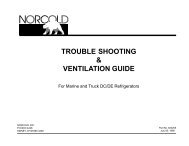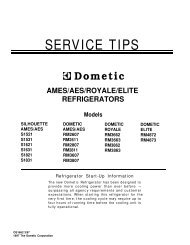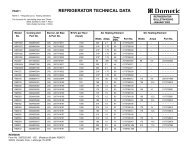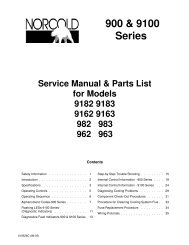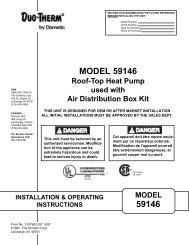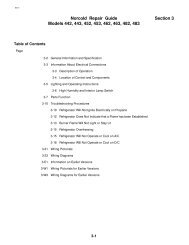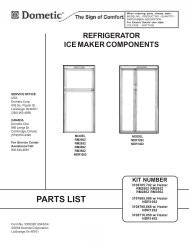service manual for 6700, 7000, 8000 & 9000 series air conditioners
service manual for 6700, 7000, 8000 & 9000 series air conditioners
service manual for 6700, 7000, 8000 & 9000 series air conditioners
- No tags were found...
You also want an ePaper? Increase the reach of your titles
YUMPU automatically turns print PDFs into web optimized ePapers that Google loves.
6. “Plugged up cap tube.”A cap tube can become stopped up by oil sludge orcontaminants in the system. This will only occur ifthe system has been open to allow moisture or othercontaminants to enter the system or if thecompressor has been overheated <strong>for</strong> a lengthy periodof time.It is difficult to determine the difference between a stoppedup cap tube and a low charge because the symptoms will benearly the same.ProblemTo rep<strong>air</strong> either a low charge or stopped up cap tube,we will have to install <strong>service</strong> valves and attachgauge manifold. If after the correct amount ofrefrigerant has been charged into the system, and ithas low charge symptoms, we will know the cap tubeis plugged and will have to be replaced.12. No heat - Heat Strip.The customer says that he has turned the selector switch to“Heat” position and the blower works OK, but no heat.Question:“What are the possible causes of “no heat”problem?”Answer: 1. “The limit switch or the heatingelement could be open.” Checkwith continuity.2. “The selector switch could be open(See page 7).”entering the return <strong>air</strong> grille of the <strong>air</strong> conditioningunit.3. Subtract from this temperature the temperature of the<strong>air</strong> immediately leaving the supply <strong>air</strong> louvers (if it isa ducted <strong>air</strong> conditioning unit, use the closestdischarge register and make sure the temperaturesensing device is measuring supply <strong>air</strong> temperatureonly).4. A properly running <strong>air</strong> conditioning unit should havea temperature difference of approximately 18 to 22degrees F. Note: Slightly less temperature differencesare possible under extremely humid conditions. (Theunit may have to run longer to remove moisture).5. Temperature differences greater than 22 degrees arepossible in warm dry weather. Restricted <strong>air</strong> flowover the evaporator may also cause greater than 22degree temperature differences.6. Compressor running amps should be checked asfollows. Note the amperage listed on the <strong>air</strong>conditioner rating plate (RLA) is determined atdesign conditions only. These conditions are 95degrees outdoor temperature and 80 degrees indoortemperature.Since the outdoor temperature is mostly responsible<strong>for</strong> the amount of compressor amperage, this figurewill have to be adjusted <strong>for</strong> changes in outdoortemperature approximately 1 amp <strong>for</strong> every 5 degreesin temperature change (from 95 degrees) up or downaccordingly.3. “The thermostat could be open(See page 7).”In all three cases, turn off power and check<strong>for</strong> continuity with an ohm meter.Problem13. Cooling Per<strong>for</strong>mance CheckMake sure the filters, the evaporator coil and the condensercoils are clean and all supply <strong>air</strong> registers are open wide.1. Start the <strong>air</strong> conditioning unit and allow it to run <strong>for</strong>at least one-half hour. Possibly longer if it isextremely warm outside (the objective is to saturatethe evaporator coil be<strong>for</strong>e we begin running atemperature test).2. With a standard dial type or digital thermometer,measure the temperature of the <strong>air</strong> immediately19



